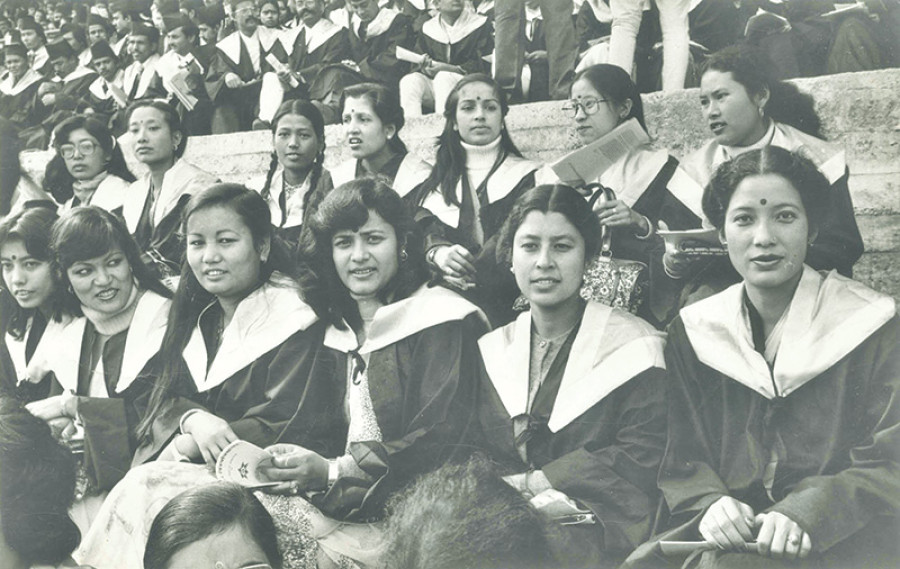Miscellaneous
The public life of women
Since 2011, Nepal Picture Library has been collecting, digitising, and documenting photographs from all types of sources with the objective of safeguarding a visual repository of ordinary life, social history, and public culture in Nepal.
Diwas Kc
Since 2011, Nepal Picture Library has been collecting, digitising, and documenting photographs from all types of sources with the objective of safeguarding a visual repository of ordinary life, social history, and public culture in Nepal.
The creation of such an archive, we believed, would thrust historical awareness in Nepal from the stodgy register of Great Men to a vision of the past where Nepali people can see themselves reflected. By the same token, we also felt that the images and the narratives of the past needed to be freed from the grips of economically and culturally dominant groups and presented to disclose—in the true spirit of inclusion and democracy—the diversities, differences, and dissensions of Nepali history.
The current exhibition is based on an ongoing archival campaign started by Nepal Picture Library in April 2018 that we titled The Feminist Memory Project. In the last six months, our research team has met over a hundred individuals who have directly given shape to the feminist landscape of Nepal or have been working to preserve the memory of past women. During this period, it became clearer to us how intensely the need for women’s history was felt. We encountered many instances where women were attempting in formal and informal ways to build chronicles and chronologies of a feminist past. The archive we are creating through The Feminist Memory Project will hopefully provide a nexus to connect these efforts.
The idea of claiming place in public life was one of the most significant themes that emerged from the materials we collected. The distinctions between the private and the public have a complex history in Nepal, as elsewhere, but these concepts are also repeatedly mobilised by women in the narratives about their own lives—describing their moves from one sphere to the other as a major transition or a breaking of barriers that held them back. By organising this exhibition around women’s relationship with public life, we want to highlight what feminist experience has felt like in Nepal. Furthermore, we think this can also show how the structures of history that push women into oblivion are in fact contingent and changeable.
We hope this exhibition can lay bare how the project of speaking and acting in the name of the common identity of “women” has unfolded in Nepal, even as it tries to do so by showing how the actual diversity of women’s lives has elaborated the different ways of being public. This exhibition is essentially a display of materials we have collated through The Feminist Memory Project. Our attempt is not to be comprehensive nor does it seek to produce a canon of exceptional and individual accomplishers. A history of women, in our opinion, is first and foremost a social history. We have curated this exhibition as a call to contribute to the archive we have started building. We seek and welcome more materials that will help us achieve this mission of a more inclusive history—and future—of Nepal.
—Curator’s statement
The Public Life of Women: A Feminist Memory Project is on exhibit at Bhai Dega, Mangal Bazaar, Patan, from 12 Oct—16 Nov, 11am-7pm, as part of Photo Kathmandu 2018

Makwanpur, 1981. In a first of its kind, factory workers from Hetauda Industrial Complex demonstrate a rally on March 8 on the occasion of International Working Women’s Day.
Bishnu Ojha Collection/Nepal Picture Library

Sahana Pradhan (right) with sister Sadhana Pradhan, brothers, and grandmother Sanu Nani. Pradhan credits her grandmother for creating the atmosphere in the house to encourage her to pursue education and for giving her the sense that she deserved no less than men.Sahana Pradhan Collection/Nepal Picture Library

Tehrathum, 1970. Two high-school teachers at their school premise. Bill Hanson

Biratnagar, 2004. Women workers at a jute textile factory.
GEFONT Collection/Nepal Picture Library

Lamjung, 1976. As part of the first batch of women to join the National Development Service, which required post-graduate students at Tribhuvan University to dedicate a year to service in a rural community, Sumitra Manandhar uses her time to see the Nepali countryside. She felt that as a Kathmandu resident and as a woman, she would not get many opportunities to travel to remote corners of the country. Sumitra Manandhar Gurung Collection/Nepal Picture Library

Shanghai, China, 1963. Shashikala Sharma stops by Shanghai during an international tour that covered the Soviet Union, China, Burma, and East Pakistan.Shashikala Sharma Collection/Nepal Picture Library

Doti, 1966. Villagers from Silgadi in farwest Nepal bidding farewell to women travelling to Kathmandu to pursue higher education. The journey of 800km back then took nearly two weeks to complete. Gomati Shrestha/Nepal Picture Library

Kathmandu, 1951. Women stage a rally to demand their right to vote during the pro-democracy revolution of 1951.Sahana Pradhan Collection/Nepal Picture Library

Kathmandu, 1981. Women from all walks of life gather for a mass meeting in Kathmandu to submit a letter of protest to the government following the rape and murder of sisters Namita and Sunita Bhandari in Pokhara that rocked the country.
Hisila Yami Collection/Nepal Picture Library

Kathmandu, 1935. Chandra Kanta Devi Malla, known as the first ‘guruama’ of Nepal, with other instructors and students. At the time when public education was seen by the ruling elites as perilous and women’s school unheard of, Chandra Kanta managed to convince the Rana government against the odds to let her open a girls’ school in Makhantole.
Chandra Kanta Devi Malla Collection/Nepal Picture Library




 8.12°C Kathmandu
8.12°C Kathmandu










